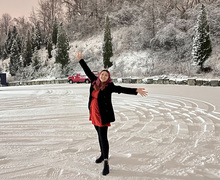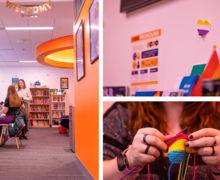A week in Florida sounds relaxing — unless you’re an SU rower
The sun glistened, shining its rays on the water bead droplets on the wooden dock.
A crystal-clear setting in 80-degree weather in De Land, Fla., – it was something the Syracuse men’s rowing team wanted to enjoy for a while. And this was their week in the sun. Each year, the men’s and women’s rowing teams spend one week in a sunny destination for winter training – to hone their technique and solidify the starting boats.
But this week, they had some company. The alligators in Lake Beresford wanted to enjoy the scene as well. Nearly every day before practice, a 5-to-6-foot alligator would make its way onto the dock, lying out to enjoy the warm weather. Whenever the men’s team came within 30 yards of the dock, though, the alligator would usually scamper back into the lake.
‘We just hit him with an oar, and then he ran away,’ said freshman walk-on Josh Mindley. ‘Luckily, the mom didn’t come back and get us.’
The fact is, there was very little that would come in the way of the team’s winter training experience in De Land during Winter Break from Jan. 7-15. The same can be said for the women’s squad, which flocked to Melbourne, Fla., from Jan 6 to 15. It was part of a busy winter for SU’s Olympic sports: The swimming and diving team also took a week-long excursion to San Juan, Puerto Rico, in January.
The trips allowed each team an opportunity to practice outside, an impossible realization in Syracuse. But the vacations weren’t as glamorous as most college students would envision. The men’s and women’s freshman squad worked on their technique and gained familiarity with the other rowers. With seasoned experience already under its belt, the varsity team, meanwhile, rowed to determine each player’s seat on the boat.
With the task at hand, there was little time for disruption. Places like De Land and Melbourne offered few distractions for the overworked rowers. With much of the day being used for rowing, the down hours consisted of resting and charging up for the next practice.
‘It’s definitely good to have the focus on rowing,’ said sophomore Ruth Frantz, a member of the women’s team. ‘It gets hard, though, because that’s all you’re doing. It’s good in getting the technique down when you get in the water. (But) in the off time, you’re like okay, ‘Now what do we do?”
Well, not much. Not unless you count the twenty hours of Dawson’s Creek, the 7-11 runs and the many hours of sleep the women’s team experienced. It wasn’t the typical way most college students would envision a trip to the Sunshine State, but for rowing purposes, the Orange lived life to the fullest.
‘That’s the one reason the coaches like this place so much, because there’s nothing to do,’ SU women’s rowing coach Kris Sanford laughed. ‘(The early morning runs) wake people up. But it’s also a good thing for general fitness. Then we pretty much rowed and rowed, miles and miles.’
That lack of recreation didn’t leave the rowers bitter, though, even if the monotony got a little boring during the free moments. Even given the freedom, the rowers stayed disciplined on their own. With such a demanding schedule, there’s good reason the women rowers rested in between practices at their hotel room at Pine Resort to get ready for the next bout.
For both the women’s and men’s sides, the day started at 6:30 a.m. Sanford divided her squad into two groups. The first group rowed for two-and-a-half hours, ate breakfast, and then ran two miles along the beach while the second group had an alternate cycle: first doing the two-mile trek, eating and then performing the rowing exercises.
The freshman team, meanwhile, worked on technique instead of intensity. The team worked on more team bonding and familiarity, while the varsity players focused more on their placement order for spring season.
‘Everyone seemed a lot more focused, intense and excited than they had been before,’ senior Tori Amling said. ‘Everyone wanted to go out there, fight and row their hardest. That was something our team was struggling with. You could feel more team spirit in the air.’
While this trip certainly stressed strong discipline, Sanford didn’t aim to make the training so demanding that it would cause massive fatigue.
‘Getting in the water with 10-11 weeks off (of not being in the water), we’re in a little bit of an adjustment period,’ assistant coach Craig Milburn said. ‘We try not to burn people out and wear them down too much. We just want to make improvements.’
Mother Nature blessed the trip with crystal clear skies and perfect rowing temperatures ranging from the 60s to 80s. That is until the last few nights when there were gusts of wind blowing from 15 to 20 mph.
But by then, the women’s team was so comfortable with each other that they successfully rowed in a narrow space – so narrow the coaches couldn’t follow behind – to avoid the wind. Just then, the team fully endured its rite of passage.
‘They were getting sick of listening to us all the time,’ Milburn joked. ‘When we get to that point (bad weather), it’s better to have that at the end of the week than if it’s done prior.’
Eppie Morton, the owner of the Orange Tree Inn, took a moment to see the women’s rowing team run one morning to Stetson University – the site where the team ate – and she was surprised.
‘They had the shorts on and I thought, ‘Man that must be cold,” Morton said. ‘They must be (from) really up north.’
When the teams weren’t rowing or running, their activities were pretty tame. Still, the SU men looked forward to their day off on Jan. 5.
Meanwhile, head coach Dave Reischman and assistant coaches Phil Marshall and Nick Scholz traded in their whistles and stop watches for golf balls and clubs at Deltona Hills Country Club.
Aside from that lone day of free time, the Orange was all business. The men’s team implemented similar tactics as that of the women, as the freshman worked on technique. The varsity squad participated in pair matrixing, a system Reischman devised in determining the order of his lineup.
That technique will ultimately determine the player’s lineup in March when the Orange
returns to its respective destination for spring training.
‘It gives the guys sort of an idea of where they stand on the team,’ Reischman said of the pair matrixes. ‘Basically, we have two weeks of water time before our first race (in March). To have a situation where you can go twice a day for seven days, not only are you getting two weeks of practice into one week, you’re getting two weeks of water opportunities.’
The Orange is used to daily workouts on the erg machines at Archbold Gymnasium and working in groups of eight with the tank – a device that supplies running water under a stationary sitting mechanism. But being able to row in fresh water in warm weather? It’s not something that’s attainable at SU.
So besides having a straight week where the sole focus was rowing, with no academics or parties to interfere, Florida served as a critical benchmark for the Orange. The training session was SU’s last in-water opportunity before regular competition begins in March.
‘Winter training can get kind of gloomy,’ said Marshall, looking around the gray, crew-training room full of erg machines. ‘It’s eight weeks of this. As you can see, it’s not the most entertaining. Having a good experience like that makes this easier because it’s a tough time for rowers in the Northeast.’
Published on January 25, 2005 at 12:00 pm





